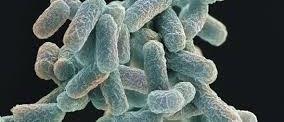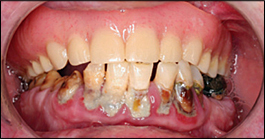The first investigation into the world of oral bacteria was first made by the father of microbiology Anthony von Leeuwenhoek (1632-1723) – who was the first microbiologist to observe and describe microorganisms accurately. Leeuwenhoek observed his mouth washings under his amateur microscope and discovered small living creatures which he called animalcules. Leeuwenhoek opined in his notebook: “I did not clean my teeth for three days and then took the material that has lodged in small amounts on the gums above my front teeth, and I found a few living animalcules in them”. Anthony von Leeuwenhoek’s serendipitous discovery as at the time set the roadmap for the development of the field of microbiology as we know it today especially the study of oral microbiology.
The oral cavity or mouth is the main portal of entry in the human body, and it is also the site for several microbial diseases that affect the general health of the body. This is due in part to the vast majority of oral bacteria found in the oral cavity; and which can become pathogenic when the hosts immune system becomes compromised or weakened as a result of stress and other physiological imbalances in the body. Periodontitis, gingivitis, dental caries or decay and dental plaque are some of the oral infections or diseases caused by pathogenic oral bacteria in humans; and these disease conditions aside halitosis (bad breath) cost millions of dollars to treat and manage.
The oral cavity if left unhygienic can become the source of other pathological conditions that affect other parts of the body. Microorganisms found in the oral cavity especially bacteria get the nutrients they require for optimum growth from the sugars and amino acids derived from ingested food as well as the saliva secreted by the salivary gland (which can be a great source of moisture for microbial growth). Though the full taxa of bacteria found in the oral cavity have not been sequenced and identified, it is believed that over 700 species of bacteria colonize the human oral cavity.
Some species of viruses, fungi (especially Candida) and protozoa have also been identified to be part of the microbial ecosystem of the oral cavity. These microcolony of microorganisms found in the oral cavity are complex and diverse in nature; and they all exists as a community. The human mouth (buccal cavity) is believed to be habitation for plethora of bacterial species (in their hundreds of thousands) with different nutritional requirements and microbial activity – all of which culminates to oral infection including gingivitis, periodontitis, and halitosis (bad breath) amongst others.
It is noteworthy that the mouth is the gateway or entry point to the body; and this is because majority of the substances including drugs, food and other materials that enter the body passes through the mouth or oral cavity before reaching their target site where they unleash their beneficial or non-beneficial activities in the host. Since it is the main entry point to the entire internal environment of the human body (excluding the nose, eyes, anus, ears and the genital organs), knowing the biology of the happenings in the mouth especially the microbial community and their relationship with the teeth, tongue and gum will go a long way to helping us understand how some oral infections and/or diseases develop.
Maintaining a healthy oral condition by taking good care of the teeth, gums and tongue will help the individual to checkmate the excesses of oral microbial flora and pathogens that may thrive to cause clinical or pathological conditions. This goes to show that there is an association between the health of the body and the health of the mouth. The gradual buildup of food particles on the teeth or gum gives room for microorganisms to buildup, and this condition can lead to several oral diseases conditions such as inflammation of the gum which can cause infections elsewhere in the body. Infections of the gum and other parts of the mouth are likely to expose an individual to the risk of contracting other microbial infections.
The human tooth (Figure 1) is a complex structure used for various purposes including chewing and biting of food and other materials that enters the mouth.

Some of the major components of the human tooth include the enamel, cement, gum, dentine and the pulp to mention but a few. Oral health is vital for systemic health, and thus it should be kept clean to avoid its colonization by pathogenic microorganisms.
References
Barrett J.T (1998). Microbiology and Immunology Concepts. Philadelphia, PA: Lippincott-Raven Publishers. USA.
Beck, J. D., Slade, G. and Offenbacher, S. (2000). Oral disease, cardiovascular disease and systemic inflammation. Periodontol, 23, 110-20.
Beers M.H., Porter R.S., Jones T.V., Kaplan J.L and Berkwits M (2006). The Merck Manual of Diagnosis and Therapy. Eighteenth edition. Merck & Co., Inc, USA.
Brooks G.F., Butel J.S and Morse S.A (2004). Medical Microbiology, 23rd edition. McGraw Hill Publishers. USA.
Champoux J.J, Neidhardt F.C, Drew W.L and Plorde J.J (2004). Sherris Medical Microbiology: An Introduction to Infectious Diseases. 4th edition. McGraw Hill Companies Inc, USA.
Davey M.E and O’toole G.A (2000). Microbial biofilms: from ecology to molecular genetics. Microbiol. Mol. Biol. Rev, 64, 847-867.
Gillespie S.H and Bamford K.B (2012). Medical Microbiology and Infection at a glance. 4th edition. Wiley-Blackwell Publishers, UK.
Jenstch, H., Pornowski, R., Kundi, G. and Gocke, R. (2003). Treatment of gingivitis with hyaluronan. J. Clin. Periodontol.,30, 159-164.
Mayooran B, Robin S and John R.T (2000). Dental caries is a preventable infectious disease. Aust. Dent. J, 45, 235-245.
Trahan L.X (1995). A review of its action on mutans streptococci and dental plaque–its clinical significance. Int. Dent. J, 45, 77-92.
Warren L (2008). Review of Medical Microbiology and Immunology. Tenth edition. McGraw Hill Companies Inc, USA.
Wilson B. A, Salyers A.A, Whitt D.D and Winkler M.E (2011). Bacterial Pathogenesis: A molecular Approach. Third edition. American Society of Microbiology Press, USA.
Discover more from #1 Microbiology Resource Hub
Subscribe to get the latest posts to your email.


